Acer rubrum, red maple, is a native deciduous medium sized tree that can grow quickly to about 70 ft. It is noted for its early spring red flowers and its red fall leaves. Red maple is common and can be found as a city tree to a forest tree to a swamp tree.
Flowers
Acer rubrum, red maple, blooms in early spring - early April. This burst of red compact flower clusters can easily be seen on the bare tree tops and you know spring is coming!
The flowers are easily out a few weeks before the leaf buds show green.
In order to bloom so early, all the flower buds and also the leaf buds are formed the previous year while the tree is still photosynthesizing and has energy to form the buds.
These abundant early spring flowers provide important nectar and pollen for the emerging insects.
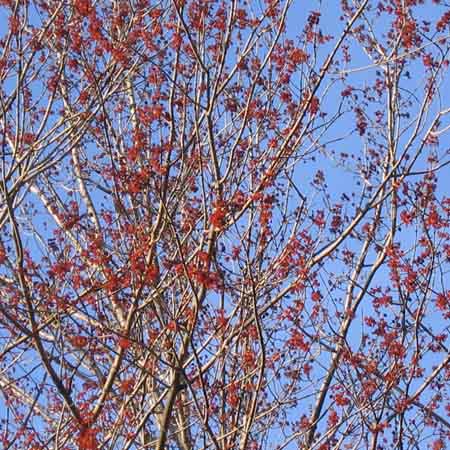
Polygamo-dioecious tree
Red maple usually is dioecious meaning that it has two kinds of flowers: male (staminate) and female (pistillate) that grow on separate trees.
However, red maple has a complex gender system. Red maple has be described as polygamo-dioecious meaning that a tree can have both male and female flowers sometimes. The term, polygamo-dioecious, is also used by some authors to include occasional bisexual flowers. When bisexual is used in discussions of red maple, it frequently is not clear if bisexual is being applied to a tree or to a flower. In the technical papers that I've looked at, no discussions of bisexual flowers were done.
Studies have shown occasionally some female flowers would appear on a male tree or some male flowers on a female tree. When there are both female flowers and male flowers on a tree, they would be on different branches. It was also found was that the functional gender of a few trees may change over the years.
Flowers:
The flower buds form on short lateral twigs. The outer parts are modified leaves called bud scales that protect the embryonic flowers as they overwinter. The bud scales are red with fuzzy pale edges. Inside of each bud are about 5 flowers that emerge in early spring before the leaves open. The flowers have 5 sepals and 5 petals that are red and look alike.
Perfect flowers (bisexual) have both stamens and pistils. However, male (staminate) flowers have stamens and a pistillode which is a nonfunctioning pistil-like structure that is not fully formed. Also female (pistillate) flowers have a pistil and staminoides which are nonfunctioning stamen-like structures that are not fully formed.
Male (staminate) flowers:
A cluster of red anthers of multiple flowers are just beginning to emerge from the bud scales. The fuzzy edges of the red bud scales can be seen.
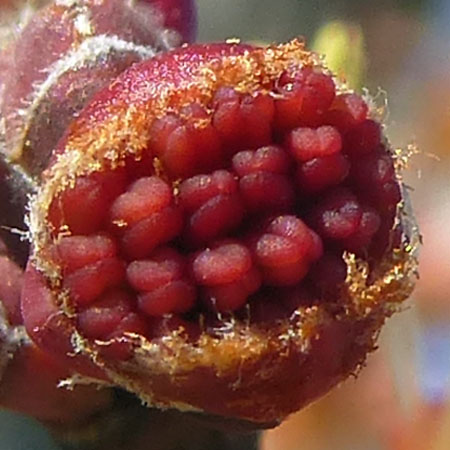
Stamens growing longer as the flower emerges. Some of the anthers are already dehiscing (releasing pollen)
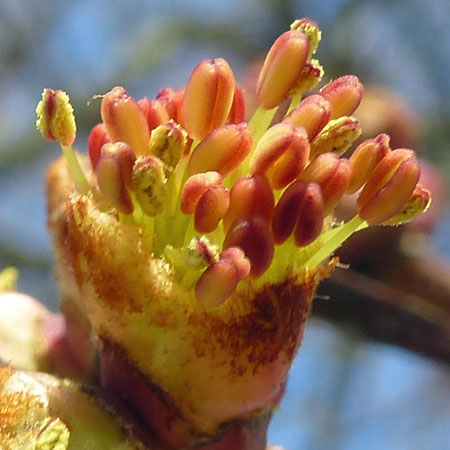
The flowers with sepals/petals emerging from the bud. Bud scales are red and the petal/sepals are deep red too.
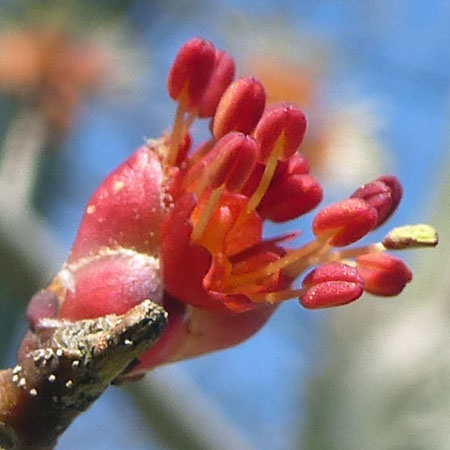
There are about 5 flowers in a bud capsule and each flower has about 8 stamens. These mature flowers have lengthened flower stalks (pedicels) and anthers that are dehiscing (releasing pollen) yellow pollen.
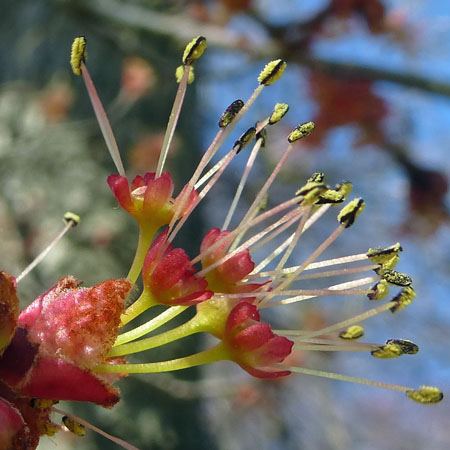
The flowers have 5 petals and 5 sepals forming two circles around the flower, the petals are on the inner side. The male flowers are frequently yellowish especially when they are mature.
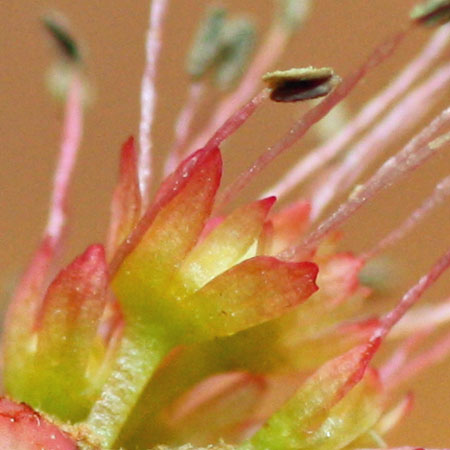
A large cluster of mature male flowers.
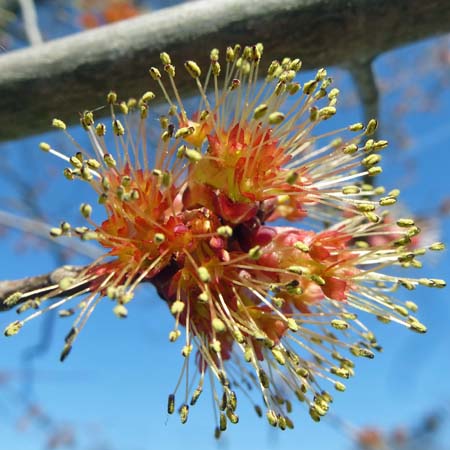
There is a nectar disk at the base of both the male and female flower. Here, in the male flower, drops of nectar can be seen between the stamens. The flower produces copious amounts of nectar.

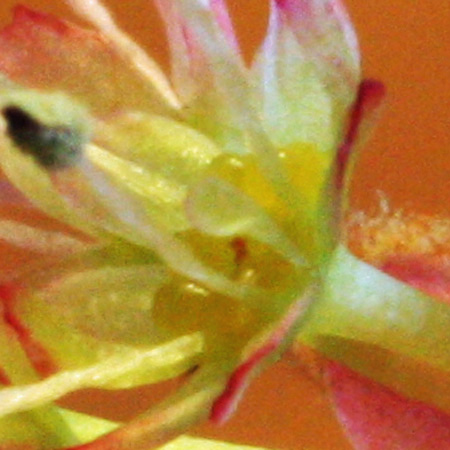
Dissected male flower showing nectary ring (red arrow) and center pistillode, non functioning female part with rudimentary double stigma (pale blue arrow)
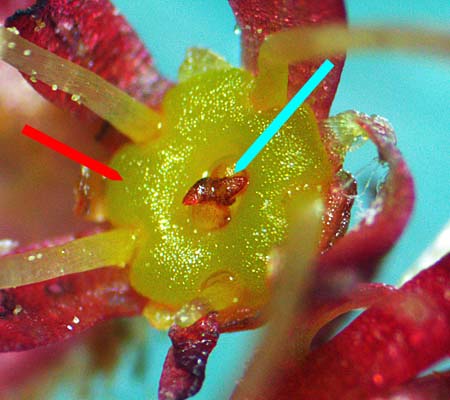
A closer look at this male flower, in between all the stamens, the pistillode can be spotted (yellow arrow). It is more developed than in the photo to the left.
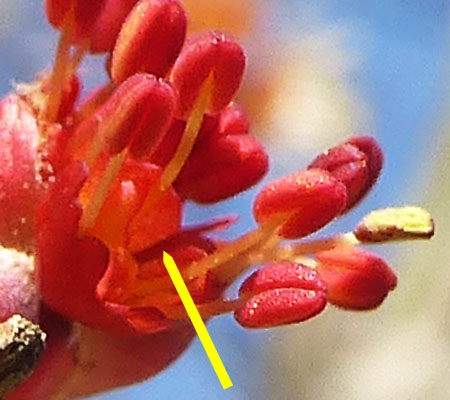
Close-up anther (male) maturing - dehissing, releasing pollen:
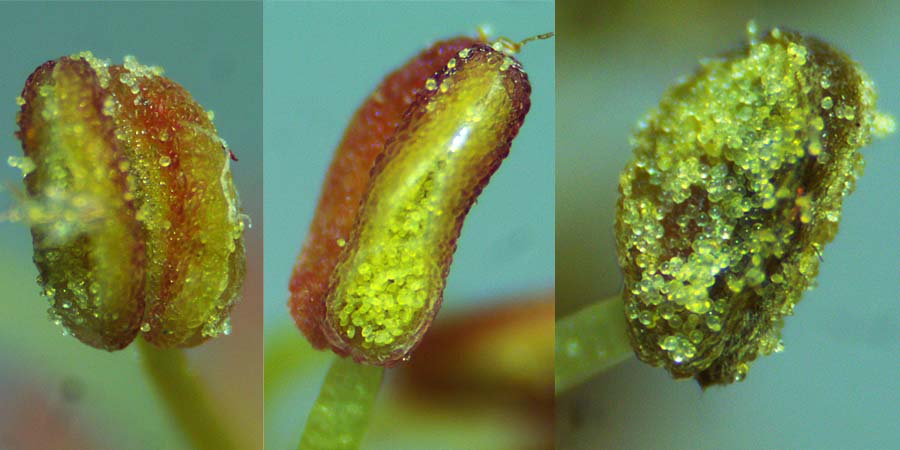
Pollen grains
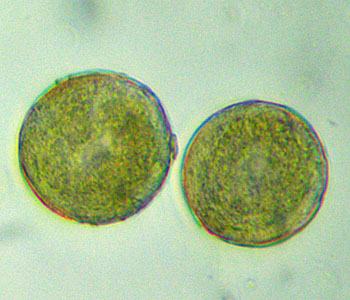
Female (pistillate) flowers:
Cluster of female flowers: red flower bud scales with pale hairy edge, multiple flowers on long pedicels (flower stalks) from a single bud, deep red 5 sepals and 5 petals, and a long bifurcated stigma from each flower.
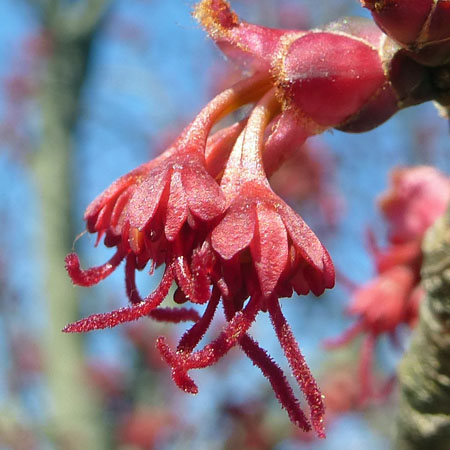
In photo below:
white arrow: female structure - stigma,
yellow arrow: male-like structure - anther-like.
Is this anther like structure a staminode (nonfunctioning) or a stamen? At a minimum, at some time the anther like structure should release pollen if it is functional for the flower to be bisexual. Most likely in this case, the structure is a staminode and the flower is female.
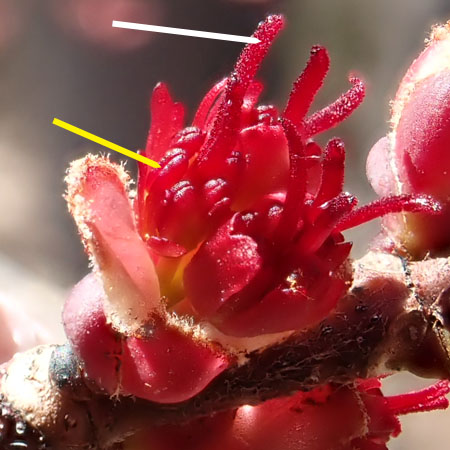
A few staminodes were dissected and were basically empty. However, a few pollen looking material was found.
What happens to the staminodes? Photo to right shows 3 staminodes that are in the process of drying up and turning black. The fuzz is from the fuzz on the bud scales. The female flower is starting to fruit. The wing formation of the ovary can be seen.
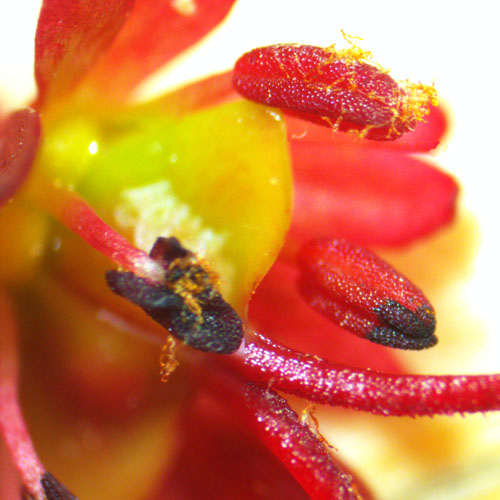
Female Nectary: Dissected flower: A large nectary (blue arrow) surrounds the base of the ovary. Ovary developing wings (green arrow). The yellow nectary produces copious amounts of nectar.

Developing fruit: Dissected flower: The pistil is divided into two, two carpels. Each developing carpel with a wing (red arrow), seed (blue arrow, and stigma (yellow arrow)
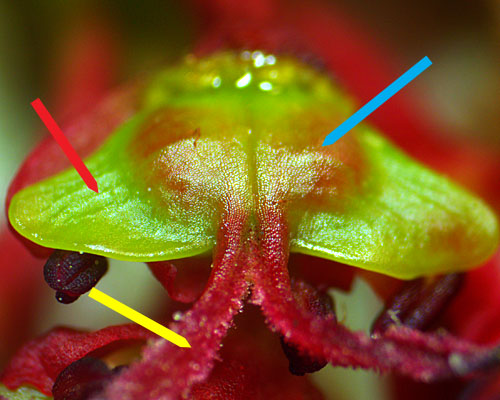
Fruit
The fruits develop from the female flowers in late April before the leaves are fully developed. The fruit is a samara which has wings and does not open when dried to release seeds. They were called “helicopters” because how they twirl as they float down. The clusters of samaras droop on long slender stems and ripen in late spring, early summer. These in the photo are redder than most. Some are almost entirely green.
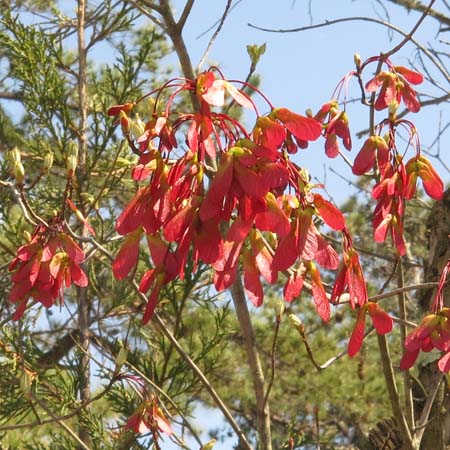

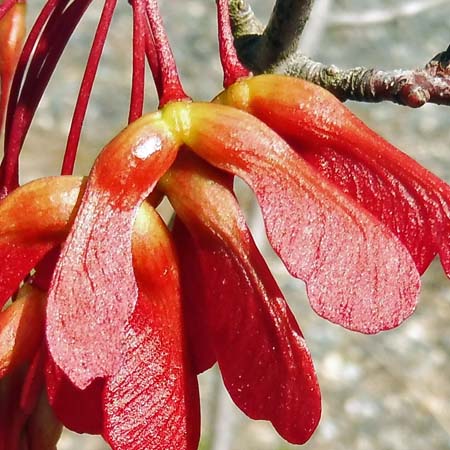
Leaves
Leaves: Red maple leaves are opposite and simple with 3 to 5 lobes. It has 5 distinct palmate veins that radiate from the stalk to each of the lobes. The two basal lobes are small or not present at all. The leaf margins on the lobes are roughly toothed. The leaves are about 5 inches long. In the fall the leaves turn to shades of red with splashes of yellow and green.
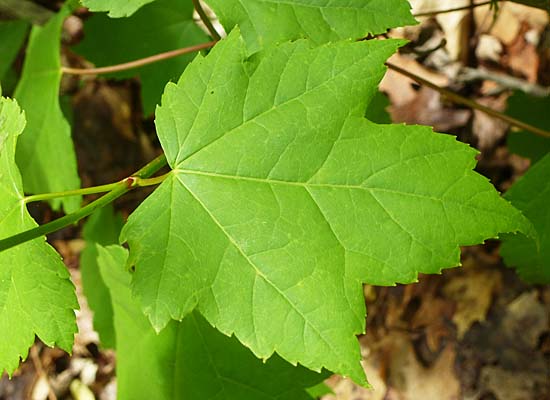
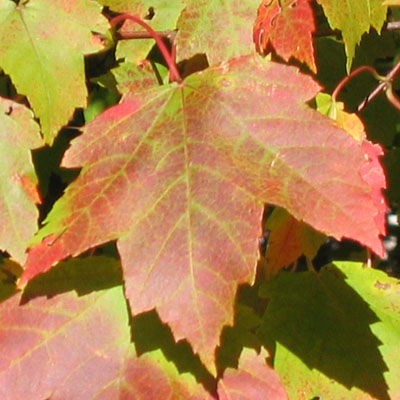
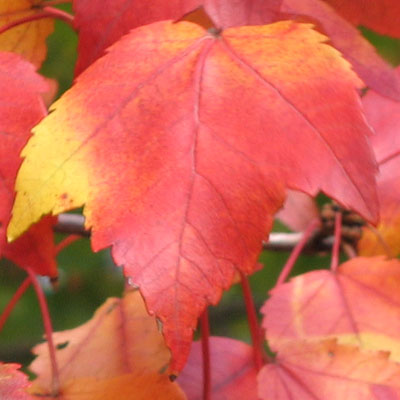

From his essay titled "Autumnal Tints", Henry David Thoreau wrote:
"How beautiful when a whole [red maple] tree is like one great scarlet fruit full of ripe juices, every leaf, from lowest limb to topmost spire, all aglow, especially when you look toward the sun! What more remarkable object can there be in the landscape?"
Plant & Habitat
The Acer rubrum tree forms a single trunk up to about 70 ft.
Red maple is one of the most abundant trees in the east. It grows in a wide range of conditions, soil, water, light, etc. It grows well in disturbed areas. It grows rapidly in the beginning. Its stump sprouts readily.
Red maple in urban setting: Chester, NJ

Red maple on small mounds in swamp: Great Swamp, NJ
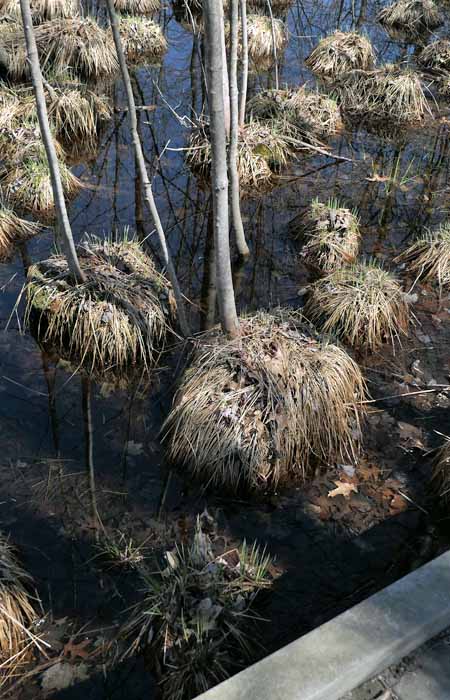
Text by Millie Ling, dissections and microscopy by Hubert Ling, and remaining photos by Hubert & Millie Ling. Photos: NJ
Additional information / References
Additional information / references:
- USDA – Acer rubrum plant guide: polygamo-dioecious https://plants.usda.gov/DocumentLibrary/plantguide/pdf/pg_acru.pdf
- Primack & McCall 1986: Gender Variation in a Red Maple Population (Acer rubrum; Aceraceae): A Seven-Year Study of a "Polygamodioecious" Species: abstract. https://www.jstor.org/stable/2444057
- Primack, Richard 2004, The Sex Life of the Red Maple. Full article on the 7 year sturdy. This article does not appear to suggest bisexual flowers, but individual trees with both male and female flowers. https://www.jstor.org/stable/42954885
- Sex Ratios of Red Maple (Acer Rubrum) Populations in Northern Lower Michigan, Ann K. Sakai, 1990. https://www.jstor.org/stable/1940310
- USDA Forest Service: Lots of info on habitat and life history. https://www.srs.fs.usda.gov/pubs/misc/ag_654/volume_2/acer/rubrum.htm
- The USDA website shows Acer rubrum county distribution NJ as well in the US and other information: https://plants.usda.gov/home/plantProfile?symbol=ACRU